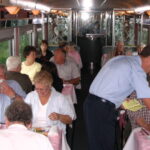Railroad Terminology: Fascinating!
Thirty years ago, when I first got the crazy idea that I could write a book about train travel, I decided I’d better improve on what little I knew about railroading.
And so I read about it . . . not to become an expert . . . but to learn enough so I could explain the basics well enough for the average reader to understand why the people running the railroads insisted that things always be done a very specific way.
Here are a few of the railroad terms I’ve found interesting:
alerter (also) deadman’s control.
If the engineer hasn’t touched one of the controls—the whistle, the throttle or the brakes—for a period of about 25 seconds, a loud horn sounds and a bright light flashes. If there is no response to that, the train will stop automatically.
A-Unit There can be three of four locomotives pulling a long passenger or freight train. This term refers to the first locomotive at the head of the train, usually the only one with an engineer.
bogie The European term for a railcar’s four-wheel assembly, which is called a truck on this side of the Atlantic.
catenary The overhead system of wires and supports from which electric engines draw the power to operate. .
consist (Pronounced CON-sist) The total number of cars, including the locomotives, making up the entire train.
cross tie The wood or concrete structure to which the rails are fastened. They’re called “sleepers” in other parts of the world.
drive wheel Any of the locomotive’s wheels that are turned by power from diesel or electric motors to move the train.
flag stop A station or location, usually (but not always) included in the timetable, at which the train will stop only in response to a signal.
foamer This is railroad slang for a railfan; someone so hooked on trains that he or she supposedly foams at the mouth when one appears. Not really a derogatory term, but not a compliment either.
FRED Mounted on the rear of all trains, this is the part of the automatic detector system that electronically alerts the crew to any mechanical problems. It’s an acronym for Flashing Rear End Device. They get the job done, but have replaced the traditional cabooses on freight trains, still missed by railroad crews. That helps explain why they often translate the acronym as “F—— Rear End Device.”


